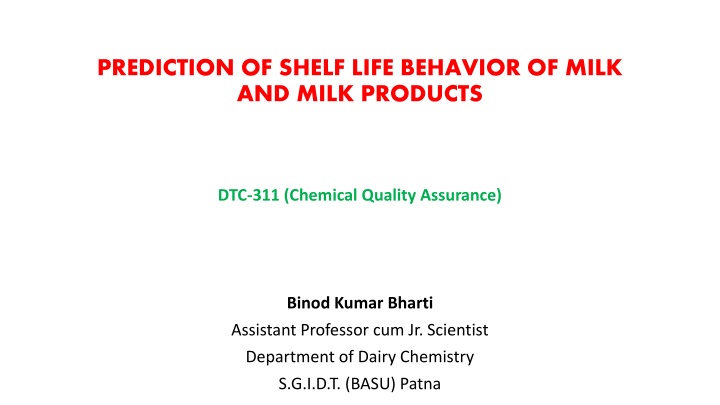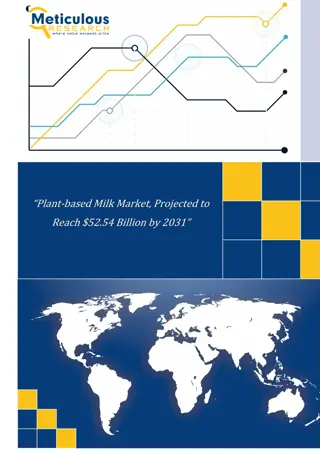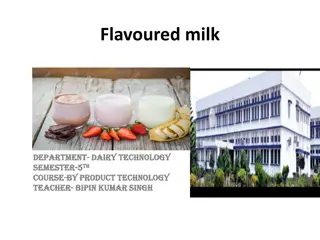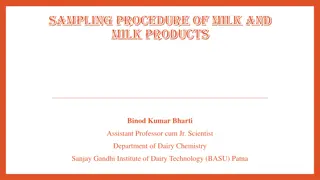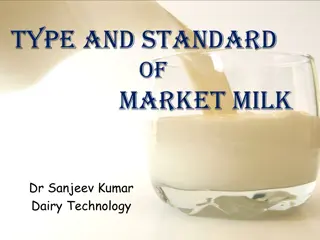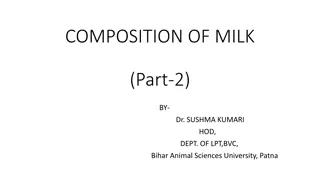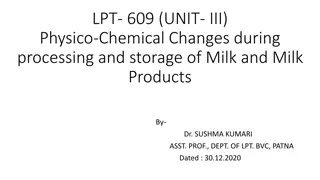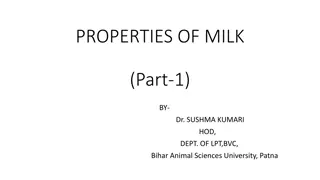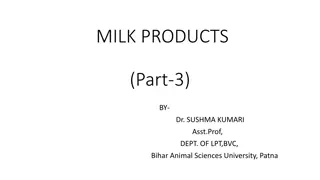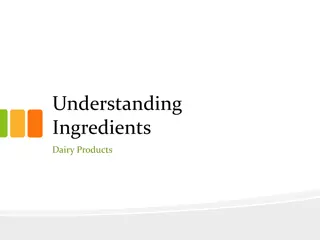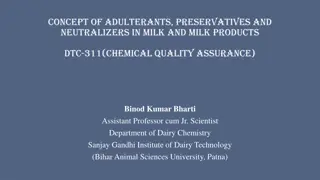PREDICTION OF SHELF LIFE BEHAVIOR OF MILK AND MILK PRODUCTS
Shelf-life is a crucial aspect for food products, ensuring safety and quality for consumers. This study delves into the definition of shelf life, methods for determining it, and factors affecting it. Understanding shelf life helps maintain food safety, quality, and consumer satisfaction.
Download Presentation

Please find below an Image/Link to download the presentation.
The content on the website is provided AS IS for your information and personal use only. It may not be sold, licensed, or shared on other websites without obtaining consent from the author.If you encounter any issues during the download, it is possible that the publisher has removed the file from their server.
You are allowed to download the files provided on this website for personal or commercial use, subject to the condition that they are used lawfully. All files are the property of their respective owners.
The content on the website is provided AS IS for your information and personal use only. It may not be sold, licensed, or shared on other websites without obtaining consent from the author.
E N D
Presentation Transcript
PREDICTION OF SHELF LIFE BEHAVIOR OF MILK AND MILK PRODUCTS DTC-311 (Chemical Quality Assurance) Binod Kumar Bharti Assistant Professor cum Jr. Scientist Department of Dairy Chemistry S.G.I.D.T. (BASU) Patna
Contents 1. Introduction 2. Shelf Life of Food 3. What is a Shelf Life Study 4. Methods of shelf life of food 5. Direct method for determination of shelf life of food i. Selection of suitable tests for determining spoilage of food ii. Planning of the shelf life study iii. Running the shelf life study iv. Monitoring the shelf life 6. Indirect methods for determination of shelf life of food i. Accelerated shelf life studies
Introduction Shelf-life is both an important concept and an important properties of food products. What is Shelf Life of Food? There are many definitions of shelf life provided by governments and organizations. The Institute of Food Science and Technology defines shelf life as the period of time during which the food product will remain safe; be certain to retain its desired sensory, chemical, physical, microbiological, and functional characteristics; where appropriate, comply with any label declaration of nutrition data, when stored under the recommended conditions. Both food safety and quality are important aspects of acceptable shelf life.Although pathogens are usually monitored during shelf-life studies. Defined as the time that a product is acceptable and meets the consumers expectations regarding food quality
A guide for the consumer of the period for food can be kept before it starts to deteriorate, provided any stated storage conditions have been followed. Describes how long a food will retain its quality during storage. Period during which food 1. Remains safe to eat 2. Keeps its appearance, texture and flavor 3. Meets nutritional claims provided on the label, if any Thus shelf-life is multifaceted property that is enormously important to food manufacturers and processors as well as consumers. The food safety and desired quality are the two main aspects of an acceptable shelf-life.
Shelf Life of Food Begins from the time the food is prepared or manufactured. Indicated by labeling the product with a date mark Dependent on many factors Types of ingredients, manufacturing process, type of packaging and storage conditions Declaration about shelf life of food Any packaged food with a shelf life of less than two years to be labeled with a date mark. Food to be safe up to, and including, the date marked.
One of the following options must be used: 1. Use by date. Used for highly perishable foods and present a safety risk if consumed after this date. A food must not be sold if it is past its Use by date, nor should it be consumed. 2. Best before date. This is used for foods other than those specified above. It is not illegal to sell food that has reached its Best before date. Storage conditions should be such that they are achievable in the distribution, retail systems and in the home. The seller should store the food according to stated storage instructions.
What is a Shelf Life Study? Many food products have some variation of open shelf-life dating marked on their containers. These dates help the consumer to decide how long the product may be stored prior to consumption. Food manufacturer conduct studies to determine the shelf-life of their product. Basically two methods are used- 1. Direct method The most commonly method used. It Involves 1. Storing the product under pre-selected conditions for a period of time longer than the expected shelf life 2. Checking the product at regular intervals to see when it begins to spoil. 2. Indirect method The approach uses accelerated storage and/or predictive modeling to determine a shelf life.
Direct method for determination of shelf life of food The most common and direct way of determining shelf-life is to carry out storage trials of the product under controlled conditions and it is likely to encounter during storage, distribution, retail display and consumer use. The Direct method involves Identification of causes for spoilage of food Selection of suitable tests for determining spoilage of food Planning of shelf life study Running the shelf life study Determination of the shelf life Monitoring the shelf life
Identification of causes for spoilage of food Three main categories of food spoilage are Physical, Chemical, and Microbiological. List out all the possible ways by which product may deteriorate in quality and/or safety.
Selection of suitable tests for determining spoilage of food An acceptable shelf-life is expected to retain desired sensory, chemical, functional, microbiological and physical characteristics of the product. All tests are not appropriate for all products. For example, one may test milk for numbers of lactic acid bacteria but not fermented milks for these organisms. In general, tests can be divided into 4 categories viz. Sensory, Physical, Chemical and Microbiological
a) Sensory Sensory evaluation assesses taste, smell, appearance, and texture of food. Taste, Smell, Appearance and Texture It is useful when determining the shelf life of a food.
b) Physical These include following tests for measuring product- Density, Viscosity, Refractive index Conductivity, Surface tension, Light absorption, Redox potential, Slip Point Solidification time Microscopic examination, etc.
c) Chemical Chemical tests can detect changes in quality of the product throughout its shelf life. Examples of chemical tests include Acidity, Free fatty acids Soluble nitrogen, TBA Crude fiber Peroxide value Protein Lactose Minerals Vitamins Lipid profile
d) Microbiological These tests can be used to evaluate both food quality and safety. Tests may be done to estimate changes in the number and type of spoilage organism occurring over time. Yeasts, Moulds Bacteria E. Coli
Planning of the shelf life study What tests need to be carried out? How long will the study run for, and how often will the tests be carried out? How many samples will be tested each time? How many samples will be needed for the whole study period? When will the study be run? How product, process and packaging are selected?
Running the shelf life study Short shelf-life products 1. Chilled foods with shelf-life of up to one week (e.g. ready meals) 2. Samples can be taken daily for evaluation Medium shelf-life products 1. Products with a shelf-life of up to three weeks (e.g. some ambient cakes and pastry) 2. Samples can be taken on days 0, 7, 14, 19, 21 and 25. Long shelf-life products 1. Products with a shelf-life of up to one year e.g. some breakfast cereals and heat-processed shelf-stable foods 2. Samples can be taken at monthly intervals 3. The exact frequency will depend on the product and on how much is already known of its storage behavior.
Determination of the shelf life The UK, the Dairy Products (Hygiene) Regulations 1995 specify microbiological criteria for milk-based products, which may be used to fix shelf-lives. Besides legal standards, voluntary guidelines can also be very useful in assisting companies to define shelf-life endpoints for their products. Using all the information which have been observed and recorded, decide how long the product can be kept and still be of an acceptable quality and safety. Maximum storage times for quality and safety may not be the same. The shelf life of a product should be whichever is shortest. Shelf life selected for product should be reasonable, not ideal and should allow safety margin.
Monitoring the shelf life Samples should be tested for the factors that the shelf life study indicated were the most important for that product- 1.Acidity 2. Loss of flavour, 3. Level of spoilage organisms etc. Samples should be taken from various points within the distribution and retail system. The records made while designing and carrying out the shelf life study will assist in the evaluation of customer complaints, trouble shooting, production and distribution problems and in reviewing the shelf life of the product. Continue to monitor the product to ensure it is safe and of good quality throughout its whole shelf life.
Indirect methods for determination of shelf life of food The food industry has a great need to obtain, in a relatively short time. Consequently, procedures have been developed to predict or estimate shelf-lives quickly. Indirect methods attempt to predict the shelf life of a product without running a full length storage trial; hence, they can be useful for products with long shelf lives. The two most common indirect methods are a. Accelerated shelf life studies and b. Predictive modeling for shelf life.
Accelerated shelf life studies There are number of approaches to accelerated shelf-life testing (ASLT) but all are concerned with how to get reliable deterioration data in a short period, what model to use and how eventually to predict the actual shelf-life of the product. Accelerated shelf-life testing is applicable to any deterioration process that has a valid kinetic model. That process may be biochemical, chemical, microbiological or physical. In practice, most accelerated tests have been done on deterioration processes that are chemical in nature. The basic idea is that the rate of a shelf-life limiting chemical reaction is increased at an elevated storage temperature. The end of shelf-life is thereby reached much quicker and the data obtained can be extrapolated to provide an estimate of the shelf-life at normal or ambient storage conditions, usually by using the Arrhenius relationship.
There are two approaches in accelerated shelf-life testing: Initial rate approach and Kinetic model approach. I. Initial rate approach The simplest technique for accelerating the shelf-life testing is the `initial rate approach. It may be applicable to cases where the deterioration process can be monitored by an extremely accurate and sensitive analytical method. To predict the actual shelf-life, one needs only to know or to evaluate how the deterioration process behaves as a function of time. In chemical reactions that information is provided by the order of reaction . Basic to any predictive use of reaction kinetics is that the relationship between the measurable changing reaction parameter and time be linear.
Labuza (1982) has reported that quality loss follows the following equation ?? ??= k QA n where dQ/dt is the change in the measurable quality factor QA, with time t, k is the rate constant in appropriate units and n is the order of the chemical reaction of the quality factor The order of reaction for most quality attributes in food products is either zero, first or second. In zero order reactions, the rate of loss of the quality factor is constant or linear and the resulting curve will be linear on a linear plot. First order reactions are not linear but are dependent on the amount of the quality factor that remains in the sample at the time. Application of first order reactions are rancidity, microbial growth and death, microbial production products, vitamin losses in dried foods, and loss of protein quality.
II. Kinetic model approach The kinetic model approach is the most common method for accelerated shelf-life testing. The process involves the following steps: Selection of desired kinetically active factors for acceleration of deterioration process. Running kinetic study of deterioration process at such levels of accelerating factors that rate of deterioration is fast enough. Evaluating parameters of kinetic model and extrapolating data to normal storage conditions. Use extrapolated data or kinetic model to predict shelf-life at actual storage conditions.
Predictive modeling for shelf life Predictive models are mathematical equations which use information from a database to predict bacterial growth or chemical change under defined conditions. Predictive models can be used to calculate the shelf life of a food. Information on the changes that occur in the product when it deteriorates the properties of the product and packaging is required for the calculations. Models are useful as a first step in the evaluation of a product s shelf life. Information of modeling programme to be verified by challenge testing or a shelf life trial. The Arrhenius model that relates the rate of a chemical reaction to the changes in temperature is the best example of such a validated model.
Arrhenius model model is represented by the this equation: k=k0 exp (-?? ??) where K0 is a constant, Ea the energy of activation, R the gas constant and T the absolute temperature. Each of the chemical deterioration reactions requires a certain amount of energy to get started. This is called activation energy The higher the activation energy is for a reaction, the greater the acceleration with increases in temperature. Asimple way to express this acceleration is to use the Q10 concept.
Q10 concept To simplify the process further, one may get over the need to evaluate K0 by using a ratio between rates of reaction when temperature is changed by any arbitrary value. The most commonly used value is 10 C and therefore the ratio between the rates of reactions is known as Q10. The value of Q10 may be calculated using the following equation. Q10 =???? ?? ???????? ??? ? ????.?? (?+10) ???? ?? ???????? ??? ? ????.(?) Q10 is an increase in rate of the reaction when temperature is increased by 10 C.
The rate of reaction being followed is doubled for the 10C temperature change. For example, if a food has a stability of 20 weeks at 20 C, then its stability will be 10 weeks at 30 C. The Q10 in this case will be 20/10 that is equal to 2. Q10 is a very common method for estimating shelf-life. The popularity of using the Arrhenius model has made it synonymous with accelerated shelf life test.
References 1. www.agrimoon.com 2. Labuza, T.P., Riboh, D., 1982. Theory and application of Arrhenius kinetics to the prediction of nutrient losses in foods. Food Technol. 36, 66 74 3. van Boekel, M.A.J.S., 2008. Kinetic modeling of food quality: a critical review. Compr. Rev. Food Sci. Food Saf. 7, 144 158 4. Corradini, M.G., Peleg, M., 2007. Shelf-life estimation from accelerated storage data. Trends Food Sci. Technol. 18, 37 47
